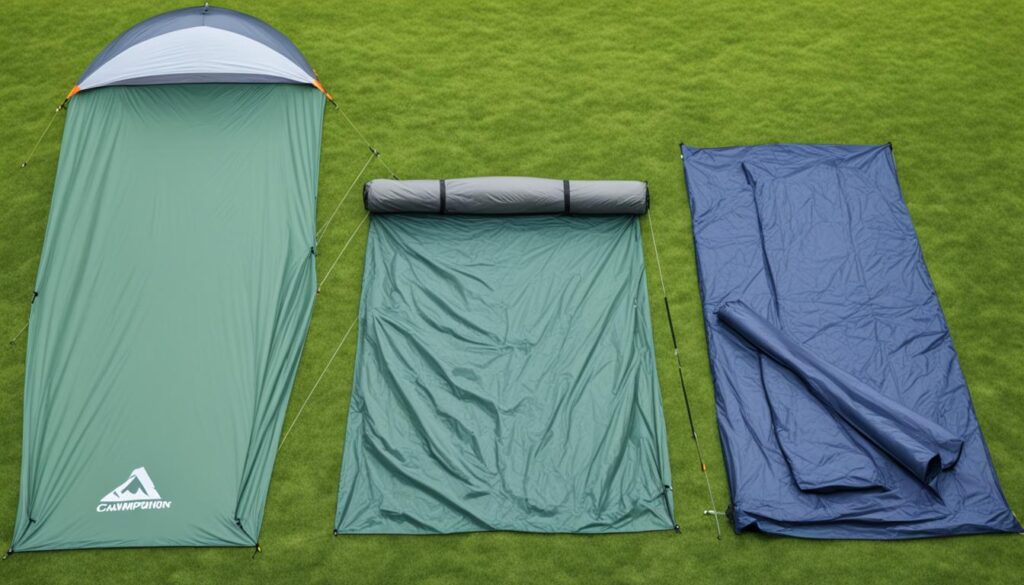
After a tough day’s hike, unzipping my tent showed a clean, dry floor. My tent’s footprint saved the day. It kept my tent new and added comfy. If you camp a lot or just started, knowing about footprints and groundsheets is key. It changes how you feel about your gear and camping.
Key Takeaways
- A tent footprint is a custom-fit groundsheet that shields the bottom of your tent from abrasion, dirt, and moisture.
- Groundsheets are more versatile but may not provide the same level of targeted protection as a footprint.
- The materials and construction of your tent footprint or groundsheet can impact durability, weight, and packability.
- The choice between a tent footprint and a groundsheet depends on your camping terrain, environment, and specific needs.
- Investing in the right floor protection can extend the life of your expensive tent and enhance your overall camping experience.
Understanding the Basics: Tent Footprints and Groundsheets
When protecting your tent’s floor, you have two main choices: tent footprints and groundsheets. Knowing the difference between them can guide your choice for camping or hiking trips. This choice makes a big difference in keeping your tent’s bottom safe from rough terrain.
What is a Tent Footprint?
A tent footprint acts like a groundsheet. It goes under your tent to shield it from sharp sticks, roots, and rocks. This way, your tent stays mud and sap-free. It doesn’t make your tent waterproof underneath, though. Most tents nowadays are waterproof at the bottom already.
What is a Groundsheet?
But, a groundsheet has a broader use. It works with different tents or as a stand-alone bed outdoors. It does the same as a tent footprint by keeping you away from the earth. It gives extra protection to your tent or sleeping bag.
Purpose and Benefits
Tent footprints and groundsheets shield your tent underneath. They just do it in slightly different ways. Tent footprints specifically fit your tent’s floor for a snug layer. Groundsheets, on the other hand, are more adaptable. They work with many tents or solo, as necessary.
Tent Footprint vs Groundsheet: A Comparative Analysis
Both tent footprints and groundsheets help keep your tent safe from the ground. But, they work a bit differently. A tent footprint fits your tent’s floor exactly. It gives a custom fit, ensuring better protection. On the flip side, groundsheets are more versatile. They work with many tents and also as a camping mat.
The tent footprint vs groundsheet comparison shows their unique uses. Tent footprints protect your tent from rough ground. They keep your floor safe from hard items like rocks and sticks. This means your costly camping gear lasts longer, while you sleep more comfortably. Groundsheets offer versatile outdoor equipment. They make a barrier between you and the ground, no matter which tent you have.
“The choice between a tent footprint and a groundsheet comes to your camping needs, the places you’ll visit, and how well you want to protect your tent. It is more about the level of floor protection your camping gear needs.”
Material and Construction: Durability Differences
When you think about how long camping gear lasts, what it’s made of and how it’s built matter a lot. This is especially true for tent footprints and groundsheets. Knowing these details can guide you in choosing the right gear for your outdoor trips.
Tent Footprint Materials
Tent footprints use light but tough fabrics like polyester or nylon. These choices are all about being able to take some rough treatment without ripping. Plus, they create a shield under your tent against the ground. This protects your tent’s floor, which is more fragile, from the rough ground and making it last longer.
Groundsheet Materials
Groundsheet materials are also picked to defend against outdoor dangers. You find options like polyethylene, polypropylene, or coated nylons. These materials provide both protection and keep water away. Adding strong seams and protecting areas that wear out boosts how long a groundsheet lasts.
Tent footprint vs groundsheet comparison: Weight and Packability
When going lightweight backpacking, how light and easy to pack your gear is matters. Both tent footprints and groundsheets keep your tent floor safe. But, their weight and pack size can really change your trip.
Lightweight Backpacking Considerations
A tent footprint being so light is a big plus for weight-watchers. They usually weigh only a bit, giving great protection without much extra camping gear weight. Yet, some groundsheets might be heavier, based on what they’re made of and how big they are. This is key info for those trying to keep their backpacking gear weight down.
Bulkiness and Pack Size
How well your tent accessories fit in your pack is crucial, especially if room is tight. Tent footprints are made to be small and simple to pack, helping you use your pack space better. However, groundsheets are usually bulkier because they serve more uses. This might take up some precious room in your camping gear setup.
Protection and Performance: Which One is Better?
Choosing between a tent footprint and a groundsheet for your tent depends on key factors. These include abrasion resistance, waterproofing capabilities, and ease of camping site selection and tent pitching. Each option serves a unique purpose for keeping your tent safe and enhancing its performance.
Abrasion Resistance
Tent footprints match the dimensions of your tent’s floor precisely, giving great abrasion resistance. This custom fit protects your tent’s fabric from rough ground like sharp rocks and branches. Groundsheets don’t fit as snugly, offering general protection but lacking in abrasion resistance.
Waterproofing Capabilities
Both tent footprints and groundsheets aim to keep your tent dry, but their waterproofing levels differ. Tents often have a waterproof layer, so a tent footprint’s added waterproofing might not matter much. Groundsheets can add more waterproofing, which is valuable in wet conditions.
Site Selection and Pitching Ease
Using a tent footprint helps in finding the best camping site and a spot to pitch your tent. Its accurate fit ensures a level and smooth area for your tent. Groundsheets also help but won’t guide you as precisely on where to pitch.
Cost and Value: Weighing the Investment
Camping and backpacking gear can be expensive. It’s crucial to think about the cost and value of items like tent footprints and groundsheets. You can find these accessories at different prices. Some are cheap, like DIY camping gear, while others are more costly, offering premium quality.
Manufacturer-Provided Footprints
Some companies make special tent footprint cost options for their tents. These footprints match their tent models perfectly, promising the best protection. However, these come with a higher price tag than general groundsheets.
DIY Footprint and Groundsheet Options
If you’re looking to save money, consider making your own DIY camping gear footprint or groundsheet. You can use materials such as tarp, Tyvek, or plastic sheeting. This lets you tailor a tent accessory value to fit your tent for much less.
Terrain and Usage: Choosing the Right Option
Choosing between a tent footprint and a groundsheet depends on where and how you camp. The ground and surroundings can impact what tent accessories you’ll need. This includes the level of protection and durability required.
Camping in Different Environments
For those who car camp and can easily move bigger items, a groundsheet shines. It’s multi-purpose, offering tent protection and serving as a mat. This makes it a smart buy for your car camping gear.
Yet, if you backpack and watch your gear’s weight and size, a tent footprint fits. It’s tailored to your tent, adding just the protection needed for your backpacking terrain, without much weight.
Backpacking vs. Car Camping
For backpackers, cutting weight and bulk is key. Opting for a small, light tent footprint could be vital. This choice can help your tent last longer, without overloading your pack.
If car camping is your style, you’re not as limited by gear size. Consider a strong groundsheet. It protects your tent well and suits other outdoor uses, too.
Conclusion
In the debate over tent footprints and groundsheets, there’s no one-size-fits-all answer. What you pick depends on your tent, where you camp, and what you need. Think about your tent’s durability, the ground you’ll be on, and how important weight is to you.
If you’re choosing between a tent footprint or groundsheet, know that each has its good and bad points. Think about what’s most important to you – protection, weight, or cost. This will help you pick what’s best for your camping trip. By looking at the advantages and disadvantages, you’ll keep your tent safe and make camping better.
When it comes down to it, choosing a tent footprint or groundsheet is up to you. Base your choice on what’s best for your own camping challenges. Knowing the differences will help you pick the right gear for your trip.
Recommended
- BEST BED TENT TO BLOCK OUT LIGHT FOR SLEEP
- BED TENT FOR TRAVEL: SLEEP COZY ON-THE-GO
- INDOOR BED TENT FOR CAMPING COMFORT & FUN

Meet Noah, the soul behind “Best Inflatable Tent” and a true wanderer at heart. Living the van life, Noah has turned his passion for exploring the great outdoors into a lifestyle, earning his living through organizing group travels that bring people closer to nature. With years of firsthand experience in the wild, Noah’s expertise in selecting and utilizing inflatable tents is unparalleled. Through this blog, he shares his profound knowledge and practical tips to help fellow adventurers find their perfect outdoor shelters. Noah’s commitment to delivering genuine, tested insights has made him a trusted authority in the camping community. Join him on this journey to discover the best inflatable tents that make the great outdoors feel like home.